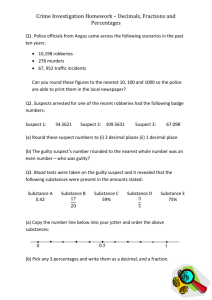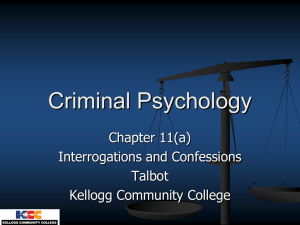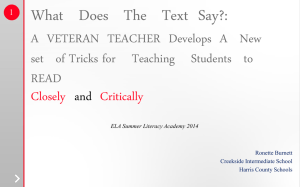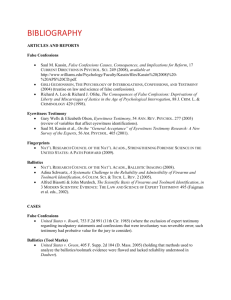Garofalo 2013
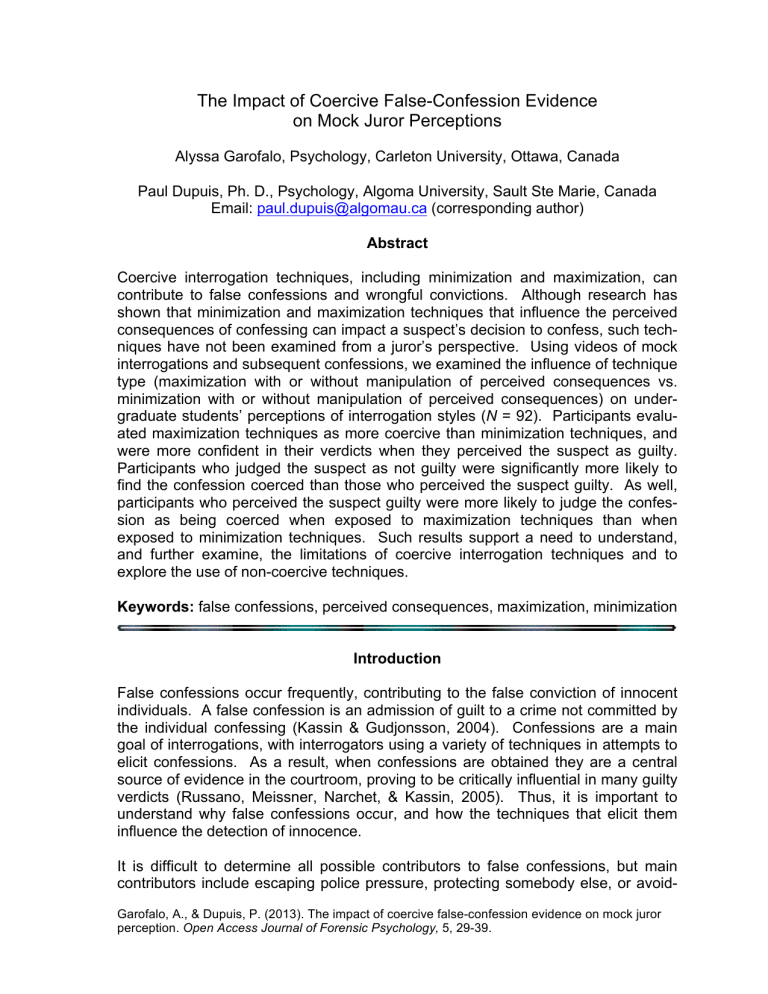
The Impact of Coercive False-Confession Evidence on Mock Juror Perceptions
Alyssa Garofalo, Psychology, Carleton University, Ottawa, Canada
Paul Dupuis, Ph. D., Psychology, Algoma University, Sault Ste Marie, Canada
Email: paul.dupuis@algomau.ca
(corresponding author)
Abstract
Coercive interrogation techniques, including minimization and maximization, can contribute to false confessions and wrongful convictions. Although research has shown that minimization and maximization techniques that influence the perceived consequences of confessing can impact a suspect’s decision to confess, such techniques have not been examined from a juror’s perspective. Using videos of mock interrogations and subsequent confessions, we examined the influence of technique type (maximization with or without manipulation of perceived consequences vs. minimization with or without manipulation of perceived consequences) on undergraduate students’ perceptions of interrogation styles ( N = 92). Participants evaluated maximization techniques as more coercive than minimization techniques, and were more confident in their verdicts when they perceived the suspect as guilty.
Participants who judged the suspect as not guilty were significantly more likely to find the confession coerced than those who perceived the suspect guilty. As well, participants who perceived the suspect guilty were more likely to judge the confession as being coerced when exposed to maximization techniques than when exposed to minimization techniques. Such results support a need to understand, and further examine, the limitations of coercive interrogation techniques and to explore the use of non-coercive techniques.
Keywords: false confessions, perceived consequences, maximization, minimization
Introduction
False confessions occur frequently, contributing to the false conviction of innocent individuals. A false confession is an admission of guilt to a crime not committed by the individual confessing (Kassin & Gudjonsson, 2004). Confessions are a main goal of interrogations, with interrogators using a variety of techniques in attempts to elicit confessions. As a result, when confessions are obtained they are a central source of evidence in the courtroom, proving to be critically influential in many guilty verdicts (Russano, Meissner, Narchet, & Kassin, 2005). Thus, it is important to understand why false confessions occur, and how the techniques that elicit them influence the detection of innocence.
It is difficult to determine all possible contributors to false confessions, but main contributors include escaping police pressure, protecting somebody else, or avoid-
Garofalo, A., & Dupuis, P. (2013). The impact of coercive false-confession evidence on mock juror perception. Open Access Journal of Forensic Psychology, 5, 29-39.
Impacts of Coercive Interrogation 30 ing detention (Kassin & Gudjonsson, 2004). There are three generally recognized types of false confessions including voluntary, coerced-compliant, and coercedinternalized. Voluntary false confessions may occur due to a desire for notoriety, to self-punishment, to mental illness, or to protection of the real criminal. In these cases, the individual willingly provides a false confession with little or no police prompting (Kassin & Gudjonsson, 2004). Coerced-compliant false confessions are induced through police interrogation when the suspect is trying to escape the negative aspects of the interrogation, avoid a threat, or gain a promised reward. At the time of the interrogation, the short-term benefits seem to outweigh the long-term consequences (Kassin & Gudjonsson, 2004). Coerced-internalized false confessions involve the suspect confessing to the crime, coming to believe in his/her guilt, and even confabulating false memories that provide details of the crime in question
(Kassin & Gudjonsson, 2004).
During an interrogation, minimization and maximization techniques are often employed. Minimization techniques minimize the seriousness of an offence, while maximization techniques rely on scare tactics to intimidate the suspect (Russano et al., 2005). Kassin and Keichel (1996) developed the first laboratory paradigm for studying the involvement of such techniques in false confessions, in which participants were instructed that the ALT key could not be pressed during a typing task or the program would crash and cause the data to be lost. However, the computer crashed regardless and the participants were accused of hitting the key. Kassin and Keichel found that, after false evidence was provided, 69% of participants signed the confession and, of these, 25% showed internalization, or belief in the confession, while 9% confabulated details. Horselenberg, Merckelbach, and
Josephs (2003) examined the effect of a higher consequence, in the form of monetary loss within the same paradigm, and obtained similar results.
In an attempt to increase generalizability, Russano et al. (2005) created a novel paradigm that used a cheating premise to elicit confessions. Staged as a problemsolving task, participants were accused of cheating and were interrogated using minimization techniques and the possibility of making a deal to reduce consequences. Participants were 1.66 times more likely to confess when minimization was used, and 1.43 times more likely to confess if offered a deal. True confessions were most likely when neither technique was used and least likely when both were used. Another interrogation technique, called the bluff technique or threat of proof, may represent the promise of future exoneration for those who are innocent (Perillo
& Kassin, 2010). After being tested in both the computer-crash and cheating paradigms, Perillo and Kassin discovered that the bluff technique also elicited high degrees of internalization and confabulation among false confessors.
Horgan, Russano, Meissner, and Evans (2011) sought to improve diagnosticity by using minimization and maximization techniques that either do or do not influence perceptions of confession consequences within the cheating paradigm. Kassin and
McNall (1991) had previously shown that many techniques imply either a threat of more severe punishment or the expectation of leniency, thus manipulating per-
OAJFP – ISSN 1948-5115 – Volume 5. 2013
Impacts of Coercive Interrogation 31 ceived consequences. While some minimization and maximization techniques do manipulate the perceived consequences of confessing, many rely solely on the demeanor of the interrogator and rapport between the interrogators and suspects to elicit a confession (Horgan et al., 2011). Techniques with no manipulation were
2.37 times more diagnostic than those with manipulation (Horgan et al., 2011).
However, it is difficult to interpret these results, as maximization and minimization techniques were collapsed as one.
Beyond attempting to understand what factors cause false confessions, some researchers have focused on how such confessions are judged. Accepting that interrogation techniques can elicit false confessions, it is important to comprehend how investigators and jurors react to these confessions. It is a common assumption that individuals can detect deception but evidence does not seem to support this notion (Kassin & Fong, 1999; Meissner & Kassin, 2002). This is particularly detrimental as confession evidence can be more powerful than other forms of evidence
(Kassin & Neumann, 1997). At the same time, Narchet, Meissner, and Russano
(2011) found that investigators with biased expectations of guilt were more likely to judge an innocent participant as guilty after the interrogation. This poses a problem since investigators typically approach an interrogation with the assumption that the suspect is guilty. Similarly, Kassin, Goldstein, and Savitsky (2003) found that investigators expecting a guilty suspect used more interrogative techniques, and were again more likely to judge the suspect as guilty. Thus, there are detrimental consequences of behavioral confirmation in the interrogative process.
The types of techniques used during an interrogation also influence jurors. Kassin and Wrightsman (1980) used trial transcripts to determine whether an individual is able to discount coerced confessions and found that participants were still likely to perceive a suspect as having committed a crime even when coercion was clear. If such coerced confessions are retracted or deemed inadmissible in court, jurors do not completely discount the confession as evidence (Kassin & Sukel, 1997). Additionally, Kassin and Wrightsman (1981) found that, even with specific judicial instructions to ignore coerced confessions, participants are still likely to judge the suspects as guilty. Woody and Forrest (2009) supported these results in discovering that the prospect of coercion having caused a confession does not significantly reduce unjust verdicts.
Undergoing training in deception detection has not been shown to increase accuracy, both in students and law-enforcement professionals, although confidence has been found to increase in professionals (Kassin & Fong, 1999; Meissner & Kassin,
2002). Similar results have been obtained when students and professionals viewed videotapes of prison inmates, although participants were more accurate in their decisions when an audiotape was used (Kassin, Meissner, & Norwick, 2005).
Levine, Kim, and Blair (2010) further exemplified such inaccuracy in professionals, as participants were typically unable to determine the difference between true and false denials. This is particularly concerning as there is obvious potential for law enforcement professionals to contribute to falsely incriminating innocent suspects.
OAJFP – ISSN 1948-5115 – Volume 5. 2013
Impacts of Coercive Interrogation 32
Further, it is pertinent to understand which interrogative techniques are most impactful in juror decisions, as their judgment is critical to verdicts. Those techniques that are least likely to negatively impact juror decisions should be examined.
Presently, much research focuses on the diagnosticity of interrogation techniques in an attempt to reduce the rate of false confessions. However, there are few studies that apply the popular cheating paradigm (Russano et al., 2005) to juror perceptions, and this area needs further exploration. By applying the cheating paradigm to juror perceptions, one can start to establish the impact of different interrogative techniques on juror judgments.
Until recently, research in the area of juror perceptions of interrogative techniques has relied mainly on trial transcripts, which pose a serious limitation with their lack of visual stimulation and detail (Kassin & Wrightsman, 1981). Providing video evidence allows the juror an opportunity to use various cues aside from the written word that will help determine if a confession is coerced, and perhaps invalid. Previously, research has been completed using video evidence of interrogations, yet the focus of these studies has been primarily on camera perspective (Lassiter, Diamond, Schmidt, & Elek, 2006).
Rather than focusing on camera biases, we examined the perceptions of mock jurors exposed to videotaped confessions depicting minimization techniques with or without manipulation of perceived consequences and maximization techniques with or without manipulation of perceived consequences (Horgan et al., 2011). The videotaped confessions were judged for guilt, confidence in verdict, voluntariness of confession, and level of coercion. Accumulating data on mock juror perceptions of common interrogative techniques may inform relevant parts of the justice system and contribute to a re-examination of the procedures used to interrogate suspects.
We expected that confessions elicited using maximization techniques would be perceived as more coercive and would result in fewer guilty verdicts, particularly when the perceived consequences of confessing were manipulated. We also expected that confessions elicited using minimization techniques would be perceived as less coercive and would result in more guilty verdicts, particularly when no manipulation of perceived consequences was used.
Materials and Methods
Participants
Ninety-two undergraduate students from Algoma University participated in this study for course credit. The mean age of participants was 18 years. This study was conducted with the approval of the Algoma University Research Ethics Board.
OAJFP – ISSN 1948-5115 – Volume 5. 2013
Impacts of Coercive Interrogation 33
Design
A 2 (minimization vs. maximization technique)
×
2 (manipulation of perceived consequences vs. no manipulation of perceived consequences) between subjects factorial design was used.
Materials
Stimulus materials. Four mock interrogations were videotaped in an office setting. Following the Russano et al. (2005) paradigm, a Caucasian male student actor was accused of having cheated during an independent task, and academic disciplinary actions were threatened. Each video briefly introduced the cheating situation by a Caucasian male adult acting as professor, and proceeded to the interrogation in which four different techniques, similar to those in Horgan et al. (2011), were used. Each video included at least two interrogation techniques. Minimization techniques that manipulate perception of consequences included acts such as minimizing the seriousness of the offence, while maximization techniques that manipulate perception of consequences included exaggeration of consequences
(Horgan et al., 2011). Minimization techniques that do not manipulate perception of consequences involved the use of a friendly demeanor, and maximization techniques that do not manipulate perception of consequences included interrogator overconfidence in guilt. Once the interrogation was complete, the student actor was asked to sign a confession statement that indicated that he had in fact shared information during a section meant for independent work (Horgan et al., 2011). The videos were approximately three minutes in length, and shot from an equal-focus camera perspective.
Demographics questionnaire. A brief demographics questionnaire was used to collect information regarding gender, age, and ethnicity.
Dependent measures questionnaire. The dependent measures questionnaire collected data on participant perceptions of the aforementioned interrogation styles. These questions included verdict (guilty or not guilty), probability that the suspect committed the crime, confidence in verdict, and how voluntary or coerced was the confession.
Procedure
Participants arrived at a computer lab and were asked to complete an informedconsent form. They were then randomly assigned to one of the four conditions
(minimization techniques that manipulate perception of consequences (n = 24), maximization techniques that manipulate perception of consequences (n = 24), minimization techniques that do not manipulate perception of consequences (n =
24), and maximization techniques that do not manipulate perception of consequences (n = 24)). Once assigned, the participants were seated at individual computers, equipped with screen shields and headphones, and were shown the
OAJFP – ISSN 1948-5115 – Volume 5. 2013
Impacts of Coercive Interrogation 34 assigned video. Once the video was complete, the demographic questionnaire and dependent measures questionnaire were distributed. Upon completing these materials, each participant received a debriefing form and was thanked for participating.
Results
A factorial analysis of variance (ANOVA) was used to examine the effect of maximization and minimization techniques, as well as techniques that do or do not use manipulation of perceived consequences, on verdict, confidence in verdict, probability that the suspect committed the crime, and voluntariness of confession. An alpha level of p < .05 was set for all statistical analyses.
Main Effects of Maximization / Minimization
There was a statistically significant main effect of maximization and minimization interrogation techniques on voluntariness of confession. Specifically, participants found the scenarios portraying maximization techniques to be more coercive ( M =
3.50, SD = 0.66) than the scenarios portraying minimization techniques ( M = 3.11,
SD = 0.77) [ F (1, 88) = 6.91, p = 0.01, η² = .07]. There were no statistically significant effects on verdict, [ F (1, 88) = 1.08, p > .05, η² = .01, N.S], probability of commission [ F (1, 90) = 0.34, p > .05, η² = .004, N.S], or confidence in verdict [ F (1, 90)
= 0.26, p > .05, η² = .003, N.S].
Main Effects of Manipulation / No Manipulation
The level of manipulation in the scenarios significantly influenced confidence in verdicts [ F (1, 88) = 4.45, p < .05, η² = .05]. Specifically, participants who viewed the interrogator use manipulation to achieve a confession were more confident in their verdicts ( M = 5.80, SD = 2.37) than those who witnessed no manipulation ( M =
4.65, SD 2.81). There were no statistically significant effects on verdict [ F (1, 90) =
0.39, p > .05, η² = .004, N.S], probability of commission [ F (1, 90) = 0.17, p > .05, η²
= .002, N.S], or perceived coerciveness of confession [ F (1, 90) = .72, p > .05, η² =
.01, N.S].
Interactions and Other Effects
No significant interactions were found. However, because the verdict decision was always the first decision made by participants regarding the scenarios, we thought that this initial decision may have impacted participants’ following decisions. This initial decision may have resulted in a level of behavioral confirmation that impacted the remaining decisions. Therefore, we examined the impact of verdict decision on the remaining dependent variables. When verdict was applied as a dichotomous independent variable (guilty vs. not guilty), a number of significant results emerged.
There was a main effect of verdict on perceptions of coerciveness in confessions [ F
(1, 84) = 8.37, p < .05, η² = .09]. Participants who judged the suspect as not guilty
OAJFP – ISSN 1948-5115 – Volume 5. 2013
Impacts of Coercive Interrogation 35
( M = 3.45, SD = 0.67) were more likely to find the confession coerced than those who found the suspect guilty ( M = 3.10, SD = 0.79).
There was also a significant interaction of verdict and technique [ F (1, 84) = 5.06, p
< .05, η² = .06]. Post-hoc analysis using Tukey’s HSD revealed that participants who found the suspect guilty in the maximization condition ( M = 3.45, SD = 0.67) were more likely to judge the confession as coerced than those who viewed him as guilty in the minimization condition ( M = 2.65, SD = 0.70) ( p = .002). As well, in the minimization condition, participants who found the suspect not guilty ( M = 3.38, SD
= 0.68) were more likely to find the confession coerced in comparison to those who judged him as guilty ( M = 2.65, SD = 0.70) ( p = .004). Participants were also more likely to believe the confession was coerced when they found the suspect not guilty in the maximization condition ( M = 3.54, SD = 0.66) rather than guilty in the minimization condition ( M = 2.65, SD = 0.70) ( p = .001).
There was also a main effect of verdict on confidence [ F (1, 84) = 12.86, p < .05, η²
= .13]. Participants who judged the suspect as guilty were more confident in their verdict ( M = 6.31, SD = 1.99) than those who judged the suspect as not guilty ( M =
4.34, SD = 2.81). The interaction between technique and verdict was approaching significance [ F (1, 84) = 3.60, p = .06, η² = .04], but Tukey’s HSD post-hoc analyses revealed significant findings. When no manipulative techniques were viewed, participants were significantly more confident in a guilty verdict ( M = 6.33, SD = 2.28) than in a not guilty verdict ( M = 3.57, SD = 2.62) ( p = .002). Among those participants who judged the suspect as not guilty, those who viewed manipulation of consequences ( M = 5.40, SD = 2.75) were significantly more confident in their verdict than those who viewed no manipulation of consequences ( M = 3.57, SD = 2.62) ( p
= .04). Finally, participants who found the suspect guilty in the manipulation condition ( M = 6.29, SD = 1.76) were more confident in that verdict than those who said not guilty in the no-manipulation condition ( M = 3.57, SD = 2.62) ( p = .001).
Discussion
It is important to understand if jurors are able to accurately discount coerced confessions when deciding on a verdict. The present research tested the hypothesis that interrogations using minimization techniques with no manipulation of perceived consequences would result in more guilty verdicts. In the past, studies have shown that, by excluding manipulation from the interrogation, suspects are more likely to give a true confession (Horgan et al., 2011). Based on such findings, one would presume that a potential juror would recognize these true confessions and judge accordingly. However, this hypothesis was not supported, and there were no significant differences in verdicts among the four conditions.
Nevertheless, maximization techniques were perceived as more coercive than minimization techniques. In previous studies examining juror perceptions, maximization and minimization techniques have been collapsed so that participants were exposed to both types of techniques in each scenario (Horgan et al., 2011). How-
OAJFP – ISSN 1948-5115 – Volume 5. 2013
Impacts of Coercive Interrogation 36 ever, studies that elicit false confessions have shown both maximization and minimization techniques to be severely detrimental to the interrogative process (Kassin
& Sukel, 1997; Russano et al., 2005). Past research has also shown that minimization and maximization techniques decrease juror confidence compared to when no techniques are used (Kassin & Wrightsman, 1980). Our results showed that participants were more confident in their verdicts when manipulation was used in comparison to when it wasn’t. We used either minimization or maximization techniques in each condition and, unlike past studies, two conditions involved no manipulation of perceived consequences, which may account for the incongruity in findings.
When participants judged the suspect as guilty, they may have felt that the pressure of manipulation caused a true confession to emerge, and thus were confident in the suspect’s guilt. On the other hand, when the participants judged the suspect as not guilty, they may have viewed the manipulation as coercive and believed that the confession was false.
When we found no significant interactions, we surmised that perhaps participants’ initial verdict decisions were impacting their subsequent reactions. We judged this a reasonable assumption based on findings by Kassin, Goldstein, and Savitsky
(2003) and Narchet, Meissner, and Russano (2011), indicating that behavioral confirmation may be an issue. Thus, it seemed pertinent to use #verdict as a quasiindependent variable and apply it to confidence in verdicts and coerciveness of confessions. In doing so, we found that participants who judged the suspect as not guilty were more likely to perceive the confession as coerced and those who judged the suspect as guilty were more likely to perceive the confession as voluntary.
Additionally, participants who judged the suspect as guilty in the maximization conditions were more likely to believe that the confession was coerced than those who judged him as guilty in the minimization conditions. Consistent with past research, participants deem maximization techniques as more coercive than minimization techniques (Kassin & Wrightsman, 1980). This expected phenomenon may be due to the blatant aggressiveness of such techniques. This is particularly evident through the finding that participants who judged the suspect as not guilty in the maximization conditions thought that the confession was more coerced than those who judged the suspect as guilty in the minimization conditions. Although coercion was used in both conditions, participants perceived more coercion in maximization scenarios.
Participants were also more confident in guilty verdicts. Of particular interest, participants in the conditions without manipulation were more confident in identifying the suspect as guilty rather than not guilty. These findings may be due to the fundamental attribution error, as people are more willing to attribute another’s behavior to dispositional rather than situational factors, and thus would neglect to see the influence of manipulative interrogation techniques and would be confident in the suspect’s guilt. Perhaps without the obvious manipulation of consequences participants had no incentive to use situational pressures as an explanation for the sus-
OAJFP – ISSN 1948-5115 – Volume 5. 2013
Impacts of Coercive Interrogation 37 pect’s behavior and defaulted to a position that the confession was due to an aspect of the suspect, his guilt, rather than of the interrogation process.
Taken as a whole, our findings have numerous implications. By showing that individuals are confident in a guilty verdict, even when the confession arose due to manipulation, our results help to establish the danger in manipulating perceived consequences. As Horgan et al. (2011) exemplified, manipulation can easily elicit false confessions. Our data suggests that mock jurors are not always able to discount a coerced confession based on manipulated consequences. To our knowledge, this was the first empirical study to use the Russano et al. (2005) paradigm, as well as different levels of manipulation, to study mock juror perceptions through video stimuli. The importance of understanding which interrogation techniques lead to false confessions, and how this occurs, is extremely important.
However, it may be equally important to further the research examining how potential decision makers (e.g. jurors) react to and perceive these techniques and confessions as their perceptions have impactful consequences in the justice system.
Although preliminary, these findings are informative and require future replication and extension for a clear picture of the perceptions of interrogation techniques, false confessions, and the potential impacts of these perceptions.
These results may also be an indication of behavioral confirmation and it would be important to examine whether or not a previous judgment regarding a suspect confession impacts future judgments related to that confession. If perceptions of future decisions are biased due to behavioral confirmation processes, this could have important implication in how both how research in this area is conducted and how procedures in justice systems are structured. The sequence of procedures may have severe consequences on numerous judgments involving a suspect confession.
Acknowledgements
This research was conducted at Algoma University and we would like to thank the university for the support and resources provided that enabled the successful completion of our study. Alyssa Garofalo, B. A., is currently in the Master’s Program in
Forensic Psychology at Carleton University. Paul Dupuis, Ph. D., is currently an
Assistant Professor of Psychology at Algoma University.
Submitted November 24, 2012 . Accepted January 6, 2013.
OAJFP – ISSN 1948-5115 – Volume 5. 2013
Impacts of Coercive Interrogation 38
References
Horgan, A. J., Russano, M. B., Meissner, C. A., & Evans, J. R. (2011). Minimization and maximization techniques: Assessing the perceived consequences of confessing and confession diagnosticity. Psychology, Crime, & Law .
Retrieved from http://works.bepress.com/ christian_meissner/56
Horselenberg, R., Merckelbach, H., & Josephs, S. (2003). Individual differences and false confessions: A conceptual replication of Kassin and Kiechel (1996).
Psychology, Crime, & Law, 8 , 1-8.
Kassin, S. M., & Fong, C. T. (1999). "I'm innocent!”: Effects of training on judgments of truth and deception in the interrogation room. Law and Human Behavior,
23 , 499-516.
Kassin, S. M., Goldstein, C. C., & Savitsky, K. (2003, April). Behavioral confirmation in the interrogation room: On the dangers of presuming guilt. Law and
Human Behavior, 27 , 187-203.
Kassin, S. M., & Gudjonsson, G. H. (2004, November). The psychology of confessions: A review of the literature and issues. Psychological Science in the Public Interest, 5 , 33-67. doi:10.1111/j.1529-1006.2004.00016.x
Kassin, S. M., & Keichel, K. L. (1996). The social psychology of false confessions:
Compliance, internalization, and confabulation. Psychological Science, 7 ,
125-128. doi:10.1111/j.1467-9280.1996.tb00344.x
Kassin, S. M., & McNall, K. (1991). Police interrogations and confessions communicating promises and threats by pragmatic implication. Law and
Human Behavior , 15 , 233-251.
Kassin, S. M., Meissner, C. A., & Norwick, R. J. (2005). "I'd know a false confession if I saw one": A comparative study of college students and police investigators. Law and Human Behavior, 29 , 211-227. doi:10.1007/s10979-
005-2416-9
Kassin, S. M., & Neumann, K. (1997). On the power of confession evidence: An experimental test of the fundamental difference hypothesis. Law and
Human Behavior, 21 , 469-484.
Kassin, S. M., & Sukel, H. (1997). Coerced confessions and the jury: An experimental test of the "harmless error" rule. Law and Human Behavior,
21 , 27-46.
Kassin, S. M., & Wrightsman, L. S. (1980). Prior confessions and mock juror verdicts. Journal of Applied Social Psychology, 10 , 133-146.
OAJFP – ISSN 1948-5115 – Volume 5. 2013
Impacts of Coercive Interrogation 39
Kassin, S. M., & Wrightsman, L. S. (1981). Coerced confessions, judicial instruction, and mock juror verdicts. Journal of Applied Social Psychology, 11 , 489-
506.
Lassiter, G. D., Diamond, S. S., Schmidt, H. C., & Elek, J. K. (2006). Evaluating videotaped confessions expertise provides no defense against cameraperspective effect. Psychological Science, 18 , 224-226.
Levine, T. R., Kim, R. K., & Blair, J. P. (2010). (In)accuracy at detecting true and false confessions and denials: An initial test of a projected motive model of veracity judgments. Human Communication Research, 36 , 82-102. doi:10.1111/j.1468-2958.2009.01369.x
Meissner, C. A., & Kassin, S. M. (2002). "He's guilty!": Investigator bias in judgments of truth and deception. Law and Human Behavior, 26 , 469-480.
Narchet, F. M., Meissner, C. A., & Russano, M. B. (2011, December). Modeling the influence of investigator bias on the elicitation of true and false confessions. Law and Human Behavior, 35 , 452-465. doi:10.1007/s10979-
010-9257-x
Perillo, J. T., & Kassin, S. M. (2010). Inside interrogation: The lie, the bluff, and false confessions. Law and Human Behavior, 27 . doi:10.1007/s10979-010-9244-
2
Russano, M. B., Meissner, C. A., Narchet, F. M., & Kassin, S. M. (2005).
Investigating true and false confessions within a novel experimental paradigm. Psychological Science, 16 , 481-486. doi:10.1111/j.0956-
7976.2005.01560.x.
Woody, W. D., & Forrest, K. D. (2009, April). Effects of false-evidence ploys and expert testimony on jurors' verdicts, recommended sentences, and perceptions of confession evidence. Behavioral Sciences and the Law, 27 ,
333-360. doi:10.1002/bsl.865
OAJFP – ISSN 1948-5115 – Volume 5. 2013
